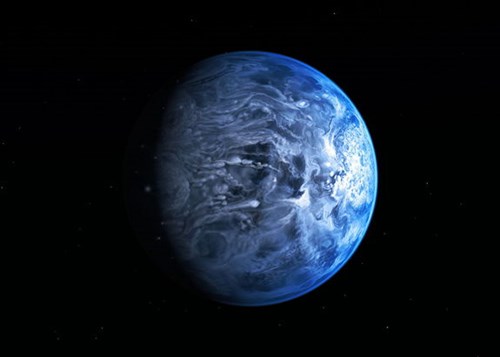Method of weighing extraterrestrial planets
The method of weighing these planets not only shows the weight of the planet, but also can reveal how friendly they are to human life.
Weigh extraterrestrial planets
Knowing the weight of a planet will help scientists better understand the structure, cooling process, stratigraphic tectonics, how a planet produces magnetic fields and circulates air in its atmosphere. From there, they can make accurate predictions about life on the planet. Therefore, this is considered a very important indicator when studying the universe.

Planet HD 189733b is applied by new scientists to calculate weight .
Currently, methods of weighing extraterrestrial planets are limited. The main technique being used is the radial velocity method : measuring the swing of a celestial body or a star while moving. That is the effect of gravity - a factor that has a close relationship with weight. However, this method is not applicable to many stars in galaxies such as stars with low mass or high flexibility.
Recently, scientists have invented a method to measure planet weights only by observing its atmosphere .
Imagine the atmosphere of a rising planet is more diluted, just like our Earth.
This is because the greater the distance, the smaller the impact of gravity .
Because the gravitational force of a planet depends on its mass , researchers can calculate the mass of a planet by observing how its atmosphere is diluted as it rises. high.
This method is named MassSpec. The researchers applied to planet HD 189733b, about 63 light-years away from Earth discovered in 2005. The results were very close to the results when using radial velocity techniques: HD 189733b heavy about 1.15 times more than Jupiter.
Currently, MassSpec is only applicable for giant gas planets equivalent to Jupiter or Saturn. Scientists are studying more to develop this promising method.
- Unknown mystery about planets outside the solar system
- Determination of extraterrestrial mass by light spectrum
- Strange weather patterns on extraterrestrial planets
- China decided to find extraterrestrial life
- America finds extraterrestrial life on 86 planets
- Detecting the outer three planets about the size of the Earth
- Alien life 'hiding' on the moons far from us?
- Is there life on Venus?
- The mysterious planet causes the orbiting star to age
- NASA announces a map of 4,000 planets outside the Solar System
- Aliens in the movie Avatar is real?
- Anyone who wants to meet aliens will be sad to know this
 Van Allen's belt and evidence that the Apollo 11 mission to the Moon was myth
Van Allen's belt and evidence that the Apollo 11 mission to the Moon was myth The levels of civilization in the universe (Kardashev scale)
The levels of civilization in the universe (Kardashev scale) Today Mars, the sun and the Earth are aligned
Today Mars, the sun and the Earth are aligned The Amazon owner announced a secret plan to build a space base for thousands of people
The Amazon owner announced a secret plan to build a space base for thousands of people NASA's 'Ninth Planet' Shows Signs of Being Friendly to Life
NASA's 'Ninth Planet' Shows Signs of Being Friendly to Life  Which planet is the oldest and youngest in the Solar System?
Which planet is the oldest and youngest in the Solar System?  Breakthrough discovery of planet with more water than Earth
Breakthrough discovery of planet with more water than Earth  How would humans die when visiting other planets?
How would humans die when visiting other planets?  Habitable planet appeared next to Earth, but met with disaster
Habitable planet appeared next to Earth, but met with disaster  Chinese spacecraft discovers mysterious cubes on other planets
Chinese spacecraft discovers mysterious cubes on other planets 